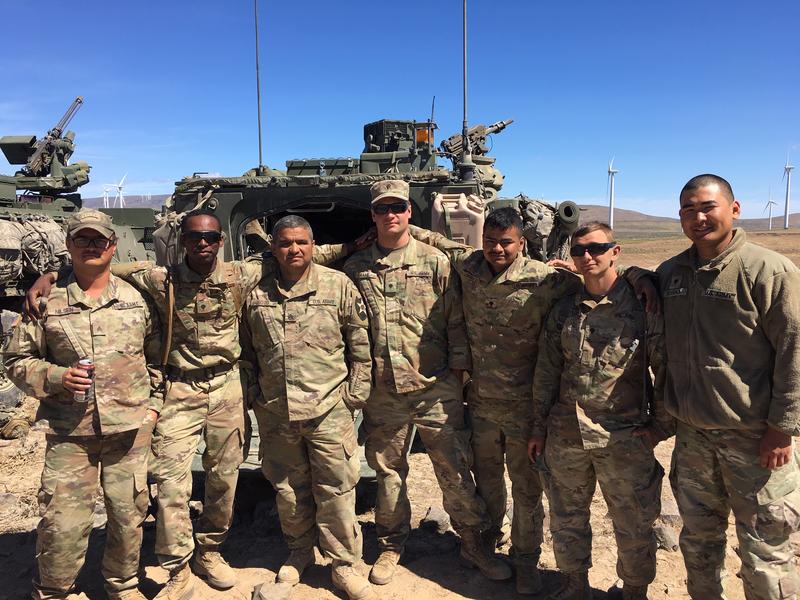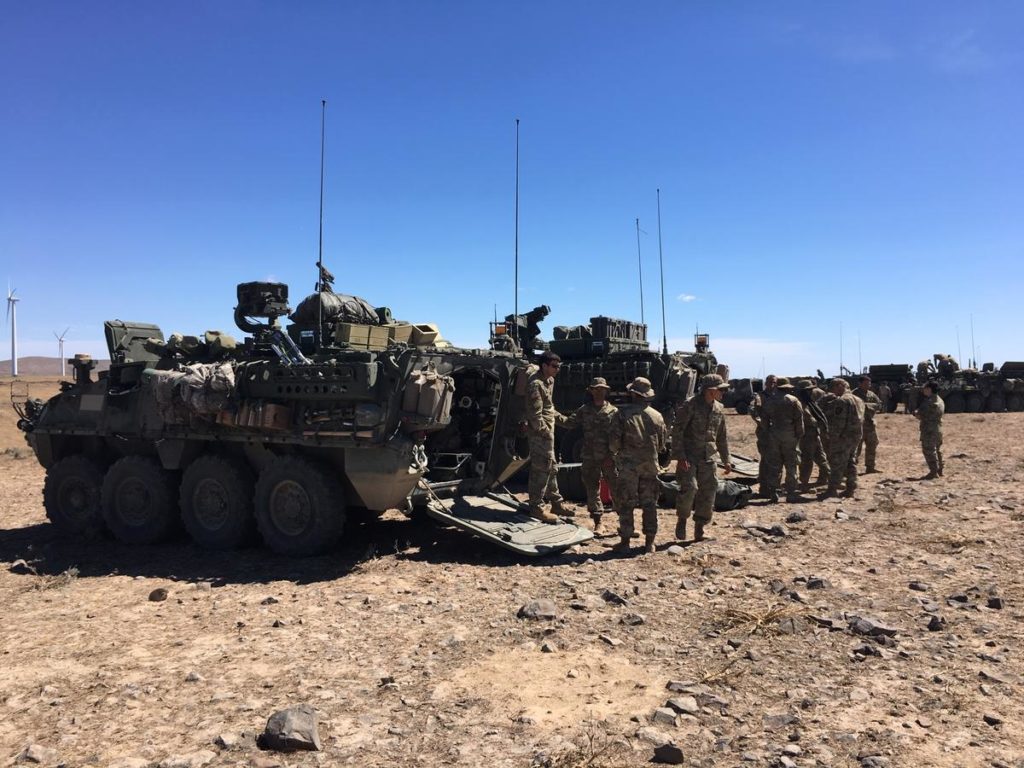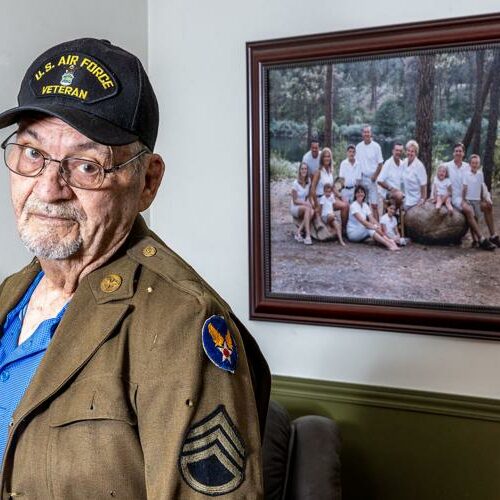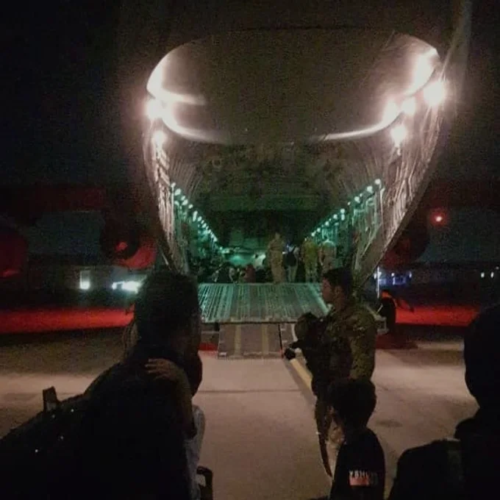
At Yakima Training Center, Thousands Of National Guard Troops Prepare For 2021 Deployment
Listen
In a dusty, sagebrush-covered ravine, a gunner unit moves with the speed of a pit crew to load a shell the size of a small bomb into a howitzer. Seconds later: boom! The wheel-mounted gun fires the shell thousands of meters down range.
Several miles away, on a windswept ridge, members of a scout platoon huddle around their eight-wheeled Stryker vehicle preparing for the next test of their combat readiness. Among them is Spc. Joshua Junious who, in his civilian life, works on the security staff of a large casino. Out here, though, his job is to do reconnaissance.
“We’re ahead of everyone else, we go out and try to figure out what’s going on, we collect intel and report it up the chain of command,” Junious said. “We’re basically the eyes on the field.”
This month, more than 3,000 Army National Guard soldiers from Washington, Oregon and California have taken up temporary residence at the Yakima Training Center, a sprawling proving ground in south central Washington that soldiers sometimes refer to as “Yakistan.”
For three straight weeks, these citizen-soldiers will withstand heat, wind, dust – and whatever else the high desert can throw at them – as they practice their combat skills during around-the-clock mock battles designed to simulate actual wartime.
They are members of the 81st Brigade Combat Team, Washington’s largest National Guard brigade, which is expected to deploy overseas in 2021. While it could change, their likely destination is Poland to participate in “Enhanced Forward Presence,” a NATO-led defensive operation launched in 2016 as a check on Russian aggression in the Black Sea region.
The 81st, which has suffered 27 casualties over the past 12 years, previously deployed to Iraq in 2004 and 2008. In addition to wartime deployments, over the decades the brigade has deployed to assist with natural disasters including the eruption of Mount St. Helens in 1980 and the Oso landslide in 2014.
Previously a tank brigade, the 81st began converting to a Stryker brigade in 2015. Strykers are eight-wheeled, armored vehicles that combine some of the functionality of a tank with the nimbleness of a truck.
But before the 81st can deploy overseas again, it will need to prove itself next summer at the Army’s Fort Irwin National Training Center (NTC) in the Mojave Desert. This summer’s training in Yakima is designed to get the brigade ready for that test.

Members of the Washington Army National Guard’s 81st Combat Brigade with their Stryker vehicles at the Yakima Training Ground. CREDIT: AUSTIN JENKINS/N3
“NTC is the Army’s way of certifying and kind of validating the force readiness of a unit in order to put them in a force-ready pool,” explained Maj. Lance Cromwell, a field artillery officer with the 81st.
On a recent morning, Blackhawk helicopters ferried a small group of reporters and photographers to a temporary battalion headquarters outpost at the Yakima Training Center.
There, three Stryker companies with about 100 soldiers each staged practice battle scenarios. The enemy was played by active duty U.S. Army soldiers.
“They’re dressed up as an opposing force to get as close as we can to simulating a combat operation,” said Maj. Nicholas Stuart, the battalion’s operations officer.
To battle safely, the National Guard soldiers, and the Army soldiers they’re fighting, use what Stuart described as an “advanced laser tag system.”
Typically, National Guard units train on weekends. But Stuart said there’s an advantage to having an uninterrupted three-week stretch of training, especially with what he calls the “big show” looming next summer at Fort Irwin.
“Sometimes problems take four days to manifest, you know four or five days, and so it gives our staff and our units more experience, more time to work through [issues],” Stuart said.
While the Stryker soldiers search out and engage with the enemy in a series of war game-like scenarios, they get support from field artillery units with their howitzers and other long-range guns.
Loading a howitzer is the ultimate team sport. As voice commands are shouted, the artillery crew leaps into action. In a matter of seconds, a 155 millimeter, high-explosive shell is rammed into the barrel and the gun readied for firing. This high-speed choreography requires everyone to know their part and their place and takes practice.
“We always preach about muscle memory,” said 1st Sgt. Adam Yoest. “We want to get you to a point of fatigue because once you get to fatigue and you build muscle memory … that means that you’re actually learning.”
Quentin Perretta is a gunner assigned to a howitzer team. He’s also a trooper with the Washington State Patrol based in Lewis County. He says this extra training time is valuable and helps him to get to know his team better. But, he adds, it’s also challenging.
“As you can see we’re dirty, grimy, stinky, so it’s a little difficult,” Perretta said. “But it’s fun. We have fun.”
Related Stories:

Washington woman joins class-action lawsuit against DOD
Every time Hayden Powell sits down to apply for a job, she has to relive an experience she went through over two decades ago, when she was discharged from the military because of her sexual orientation.

70 years later, Korean War vet reflects on enlistment
It’s been over 70 years since the end of the Korean War. Although it’s known as the “Forgotten War,” the people who were in it aren’t all gone. One of them is 90-year-old Richard Larsen of Clarkston. NWPB’s Rachel Sun spoke with Larsen about his time in Korea.

Hundreds Of Afghan Co-Workers Waiting To Be Processed A Year Later
For over a year, a group of Active Duty and National Guard Green Berets formerly known as Team 11 have been helping their Afghan co-workers leave the war torn country. Members of the National Mine Reduction Group and their families are seeking refugee status.















